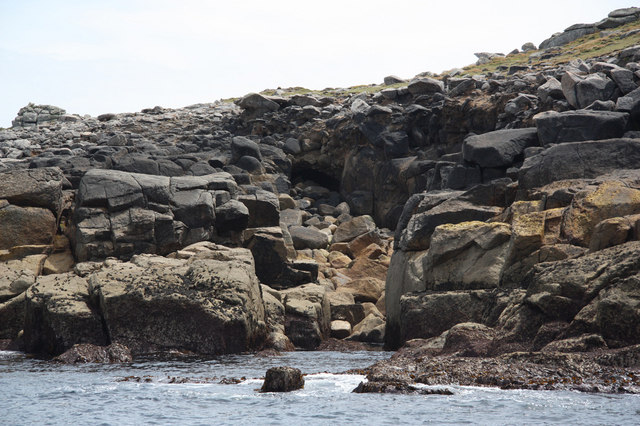The Monster of Piper’s Hole: Scilly July 4, 2015
Author: Beach Combing | in : Modern , trackbackThis was one that really got the curiosity going. Samuel Drew was an early nineteenth-century author who have we visited a couple of times on this blog: once while describing a Cornish bear monster (about 1500 years after bears had disappeared from Cornwall) and once being set up as the author of a fictional sky battle by modern internet sorts. In Drew’s History of Cornwall he very occasionally talks about local folklore beasts, but not approving of folklore (strange isn’t it?) he is often allusive. This is one of these frustrating moments, but it is included here in a desperate attempt to rehabilitate a now lost Cornish sea-land-cave bogey. We are on the Scilly Isles just off the south-west of England:
At the base of this pile, and nearly level with the sea, there is a subterraneous cavern called Piper’s Hole which is said to communicate under the surrounding waves — a distance of about four miles – with the island of Trescaw, where another orifice is seen that goes by the same name. At the mouth of the cavern it is sufficiently high for a man to stand upright, but grows narrower as you advance, presenting obstructions which few have presumed to encounter. At a little distance from the entrance, several excavations in the rocks appear, resembling rock basins, which are continually running over with water incessantly dropping from the roof and sides.
Of course, tradition is full of mysterious and generally non-existent passageways under the ground. It is what comes next that is interesting, and unfortunately incomplete.
Many marvellous stories are related of this passage — of men having proceeded so far as to be seen no more; lost either through some intricacy in the unknown labyrinth — some frightful precipice over which they have fallen – some abyss of water, into which they have been plunged — or some unheard of monster by which they have been devoured!
This might sound generic but this is what Drew does. He filters tradition into general terms. Beach’s guess, reading these words, is that there was a tradition of precipice within the tunnel but also a monster. Beach’s question is ‘what is this monster?’ There is nothing in British tradition that lurks and kills in caves at the water’s edge: or is there, drbeachcombing AT yahoo DOT com Drew continues:
It has also been asserted upon the same venerable authority, that dogs have occasionally found their way through this Tartarean gulf, and that, entering at St. Mary’s, they have actually come out in Trescaw with most of their hair off. Such are the tales which ignorance or superstition invents, which tradition propagates, and credulity receives.
Quite.
21 July 2015:
LH writes: Regarding things that “lurk and kill in caves at the water’s edge”; this is actually a common and widespread theme in British and Irish folklore, with such stories cropping up in Gaelic, Irish and English-language tradition, amongst others. Throughout the British Isles there are stories of musicians, normally pipers or fiddlers, occasionally drummers, descending into caves, playing their instrument either to signal to others that they are alright or to indicate how deep the cave goes. In the School of Scottish Studies Archives at the University of Edinburgh (archive reference SA1955.152.A3) Robert Stewart tells the tale of how a young clansman dived down through a pool to find a cave of gold below the Castle of Gight in Fyvie, Aberdeenshire, with a dangerous beast in it, signalling his meeting with the creature by playing a lament. In Irish and Gaelic lore the tale is frequently connected with the fairies, with the location (usually a cave, sometimes a sea cave) being their realm which the humans encroach upon. We can see this in MacDougall (1978: 38), also in MacLean (1923) where a party of men penetrating the cave are attacked by ‘a fairy woman’ (1923: 152-3), and in three Irish versions which name the cave or associated pool as fairy places (MacNeill 2008: 166; 175; 668-9) There are also English examples to be found in Simpson and Westwood’s excellent gazetteer The Lore of the Land. We may also note that in Beowulf, originally part of an oral tradition and considered the earliest example of “English” literature, Grendel’s fearsome mother lives in an underwater cave.
Sources:
‘The Black Lad MacCrimmon and the Banshee’. Collected by Rev. James MacDougall, published 1910. In MacDougall, J., Highland Fairy
Legends, Ed. Alan Bruford. Cambridge: D.S. Brewer Ltd., 1978: 35-37.
Maclean, JP. History of the Isle of Mull, 1923, 152-3.
MacNeill, Máire. The Festival of Lughnasa: A Study of the Survival of the Celtic Festival of the Beginning of Harvest. Dublin: Comhairle Bhéaloideas Éireann, 2008.



